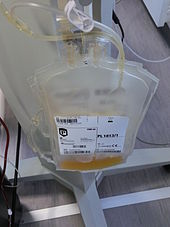Blood plasma
Blood plasma (ancient Greek πλάσμα plásma 'structure'), or plasma for short, is the liquid and cell-free portion of blood obtained when an unclotted blood sample is centrifuged. As a result of centrifugation, this fluid no longer contains blood cells (erythrocytes, platelets and leukocytes). Unlike blood serum, however, blood plasma still contains all clotting factors and is the starting material for plasma fractionation. Blood plasma accounts for about 50-59 % of the blood volume in men and 54-73 % in women.
![]()
This article or subsequent section is not sufficiently supported by evidence (e.g., anecdotal evidence). Information without sufficient evidence may be removed in the near future. Please help Wikipedia by researching the information and adding good supporting evidence.
does all the information refer to the annexed footnotes?
Blood plasma serves as a transport medium for glucose, lipids, hormones, metabolites, carbon dioxide and oxygen. However, its oxygen transport capacity is much lower than that of hemoglobin in red blood cells; it may increase under hyperbaric (elevated pressure) conditions. It is also the storage and transport medium of clotting factors, and its protein content is necessary for maintaining the colloid osmotic pressure of the blood.
The proportion of blood plasma in the body weight is about five percent, which corresponds to a volume of about 3.5 liters in a 70 kg person. The density is 1028 g/l.
Blood plasma can be obtained by centrifuging blood that has previously been mixed with an anticoagulant (see Coagulation), such as sodium citrate. The plasma obtained in this way is usually yellowish-clear and is used for plasma donation (in this case it is called fresh frozen plasma). However, if the plasma obtained is milky-white, it is called "lipemic" (fatty) and is not released for transfusion. This may be caused by a problem with the donor's fat metabolism or simply by a high-fat meal that immediately preceded it. If the collected plasma is reddish to red in color, it is described as "hemolytic." Red blood cells have burst and hemolysis has occurred.

Plasmapheresis device

Bag with fresh blood plasma
Components
Blood plasma consists of 90 to 91% by weight water, the rest being dissolved substances. These include blood proteins, inorganic electrolytes, glucose and urea.
|
| ||||||||||||||||||||||||||||||||||||||||||||||||||||||||||||||
See also
- Plasma level
- Plasma sequencing
Questions and Answers
Q: What is blood plasma?
A: Blood plasma is the yellow liquid part of blood that makes up around 55% of the total blood volume.
Q: What is plasma made up of?
A: Plasma is mostly water (around 90% by volume) and contains dissolved proteins, glucose, clotting factors, mineral ions, hormones and carbon dioxide.
Q: How is blood plasma prepared in hospitals?
A: An anti-coagulant is used to stop blood clotting and the tubes of blood are spun very fast in a centrifuge. The blood cells go to the bottom of the tubes and the plasma is poured into another container.
Q: What are the different types of blood products that hospitals may give patients?
A: Hospitals may give patients saline solution (pure water plus salt) for blood volume, blood plasma, packed red cells, whole blood, and blood serum (which is blood plasma without fibrinogen or the other clotting factors).
Q: What is plasmapheresis?
A: Plasmapheresis is a medical therapy in which blood plasma is taken out of the patient, treated, and then put back in.
Q: What is the role of plasma in excretion?
A: Plasma is the transport medium for excretion.
Q: What is the volume of water in plasma?
A: Plasma is mostly water (around 90% by volume).
Search within the encyclopedia